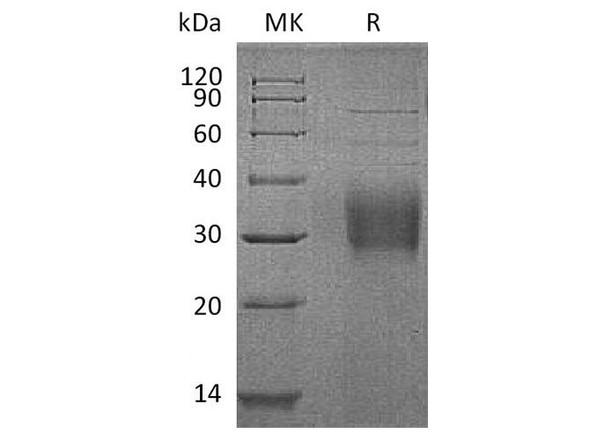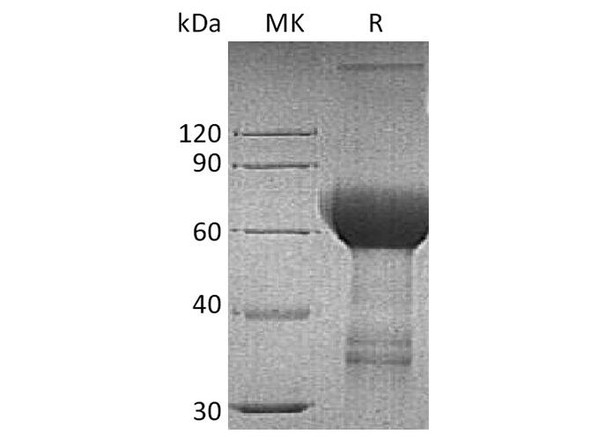Description
| Product Name: | Human TACSTD2 Recombinant Protein |
| Product Code: | RPPB4897 |
| Size: | 25µg |
| Species: | Human |
| Target: | TACSTD2 |
| Synonyms: | EGP-1, EGP1, GA733-1, GA7331, GP50, M1S1, TROP2, Cell surface glycoprotein Trop-2, Membrane component chromosome 1 surface marker 1, Pancreatic carcinoma marker protein GA733-1. |
| Source: | Escherichia Coli |
| Physical Appearance: | Sterile Filtered colorless solution. |
| Formulation: | TACSTD2 protein solution (1mg/ml) contains 20mM Tris-HCl buffer (pH 8.0), 0.4M urea and 10% glycerol. |
| Stability: | Store at 4°C if entire vial will be used within 2-4 weeks. Store, frozen at -20°C for longer periods of time. For long term storage it is recommended to add a carrier protein (0.1% HSA or BSA).Avoid multiple freeze-thaw cycles. |
| Purity: | Greater than 90% as determined by SDS-PAGE. |
| Amino Acid Sequence: | MGSSHHHHHH SSGLVPRGSH MGSQDNCTCP TNKMTVCSPD GPGGRCQCRA LGSGMAVDCS TLTSKCLLLK ARMSAPKNAR TLVRPSEHAL VDNDGLYDPD CDPEGRFKAR QCNQTSVCWC VNSVGVRRTD KGDLSLRCDE LVRTHHILID LRHRPTAGAF NHSDLDAELR RLFRERYRLH PKFVAAVHYE QPTIQIELRQ NTSQKAAGDV DIGDAAYYFE RDIKGESLFQ GRGGLDLRVR GEPLQVERTL IYYLDEIPPK FSMKRLT |
Tumor-associated calcium signal transducer 2 (TACSTD2), is a member of to the EPCAM family. TACSTD2 is an intronless gene which encodes a carcinoma-associated antigen. TACSTD2 may act as a growth factor receptor and as a cell surface receptor that transduces calcium signals. Mutations of TACSTD2 have been associated with gelatinous drop-like corneal dystrophy.
TACSTD2 Human Recombinant produced in E.Coli is a single, non-glycosylated polypeptide chain containing 267 amino acids (31-274a.a.) and having a molecular mass of 29.9kDa. TACSTD2 is fused to a 23 amino acid His-tag at N-terminus & purified by proprietary chromatographic techniques.
| UniProt Protein Function: | TACSTD2: May function as a growth factor receptor. Defects in TACSTD2 are the cause of gelatinous drop-like corneal dystrophy (GDLD); also known as lattice corneal dystrophy type III. GDLD is an autosomal recessive disorder characterized by grayish corneal amyloid deposits that cause severe visual impairment. Belongs to the EPCAM family. |
| UniProt Protein Details: | Protein type:Membrane protein, integral; Receptor, misc. Chromosomal Location of Human Ortholog: 1p32 Cellular Component: basal plasma membrane; cytosol; extracellular space; integral to plasma membrane; lateral plasma membrane; membrane; nucleus Molecular Function:protein binding; receptor activity Biological Process: cell proliferation; cell surface receptor linked signal transduction; negative regulation of stress fiber formation Disease: Corneal Dystrophy, Gelatinous Drop-like |
| NCBI Summary: | This intronless gene encodes a carcinoma-associated antigen. This antigen is a cell surface receptor that transduces calcium signals. Mutations of this gene have been associated with gelatinous drop-like corneal dystrophy.[provided by RefSeq, Dec 2009] |
| UniProt Code: | P09758 |
| NCBI GenInfo Identifier: | 160113102 |
| NCBI Gene ID: | 4070 |
| NCBI Accession: | P09758.3 |
| UniProt Secondary Accession: | P09758,Q15658, Q6FG48, Q7Z7Q4, Q96QD2, |
| UniProt Related Accession: | P09758 |
| Molecular Weight: | 35,709 Da |
| NCBI Full Name: | Tumor-associated calcium signal transducer 2 |
| NCBI Synonym Full Names: | tumor-associated calcium signal transducer 2 |
| NCBI Official Symbol: | TACSTD2�� |
| NCBI Official Synonym Symbols: | EGP1; GP50; M1S1; EGP-1; TROP2; GA7331; GA733-1�� |
| NCBI Protein Information: | tumor-associated calcium signal transducer 2 |
| UniProt Protein Name: | Tumor-associated calcium signal transducer 2 |
| UniProt Synonym Protein Names: | Cell surface glycoprotein Trop-2; Membrane component chromosome 1 surface marker 1; Pancreatic carcinoma marker protein GA733-1 |
| Protein Family: | Tumor-associated calcium signal transducer |
| UniProt Gene Name: | TACSTD2�� |
| UniProt Entry Name: | TACD2_HUMAN |






